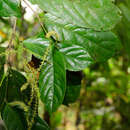Description
provided by eFloras
Shrubs or trees up to 15(-20) m tall; young branches pubescent, glabrescent. Stipules linear to lanceolate, 2-7(-13) × 0.5-1.5 mm, pubescent, caducous or persistent; petiole 2-10(-20) mm, pubescent, glabrescent; leaf blade elliptic, oblong, lanceolate, or linear, more rarely slightly ovate or obovate, (1.5-)3-25 × (0.4-)1.5-10 cm, membranous to leathery, glabrous except midvein and lateral veins pubescent on one or both surfaces, sometimes pubescent along margin, rarely abaxially slightly pubescent throughout, shiny and drying olive green to grayish green on both sides, often lighter abaxially, base acute or obtuse, rarely rounded, apex acuminate, acute, or obtuse, mucronate or not; domatia sometimes present; major veins impressed or flat adaxially, lateral veins 6-12 pairs, tertiary venation weakly percurrent or reticulate. Inflorescences axillary or terminal, males 1-13 cm, unbranched to 10(-40)-branched, females 1-10 cm, unbranched to 6-branched, fruiting 2.5-20 cm, axes glabrous or pubescent. Male flowers sessile to pedicellate; pedicels to 1.5(-2) mm, glabrous to pubescent; calyx shallowly cup-shaped; sepals 3 or 4(or 5), free to fused for ca. 1/2 of their length, 0.5-0.8 mm, broadly ovate or rounded to obtuse, rarely acute, pubescent to glabrous outside, glabrous inside but often with long hairs at base, margin usually glandular-fimbriate to lacerate; disk cushion-shaped, fully or partially enclosing bases of filaments and pistillode or annular and 3-5-lobed, lobes extending inward between filaments to pistillode, glabrous, very rarely with some hairs; stamens 3-5(or 6), 1-2 mm; rudimentary ovary clavate, hemispheric, or terete, apex obtuse, sometimes obscurely lobed. Female flowers: pedicel 0.2-1.5 mm, fruiting 1-4 mm, glabrous to pubescent; calyx cup-shaped; sepals 3-5(or 6), 0.3-1 mm, triangular to ovate, otherwise as in males; disk glabrous, very rarely with some hairs; ovary glabrous, very rarely with some hairs; stigmas 2-6. Drupes ellipsoid, terete, (3-)5-6(-8) × 2.5-4(-6) mm, glabrous; styles terminal, very rarely slightly subterminal.
- license
- cc-by-nc-sa-3.0
- copyright
- Missouri Botanical Garden, 4344 Shaw Boulevard, St. Louis, MO, 63110 USA
Distribution
provided by eFloras
Guangdong, Guangxi, Guizhou, Hainan, Hunan, Sichuan, Taiwan, Xizang, Yunnan [Bangladesh, Bhutan, Cambodia, India, Indonesia, Japan, Laos, Malaysia, Myanmar, Philippines, Thailand, Vietnam; Australia].
- license
- cc-by-nc-sa-3.0
- copyright
- Missouri Botanical Garden, 4344 Shaw Boulevard, St. Louis, MO, 63110 USA
Habitat
provided by eFloras
Forests, along rivers; 100-1500 m.
- license
- cc-by-nc-sa-3.0
- copyright
- Missouri Botanical Garden, 4344 Shaw Boulevard, St. Louis, MO, 63110 USA
Antidesma montanum: Brief Summary
provided by wikipedia EN
Antidesma montanum is a species of tree in the family Phyllanthaceae, native to Southeast Asia, from India to the Philippines. It can grow up to 10 m (33 ft). The fruits are edible. Four varieties have been accepted, each of which has multiple synonyms, which include Antidesma obliquinervium for A. montanum var. montanum.
- license
- cc-by-sa-3.0
- copyright
- Wikipedia authors and editors

